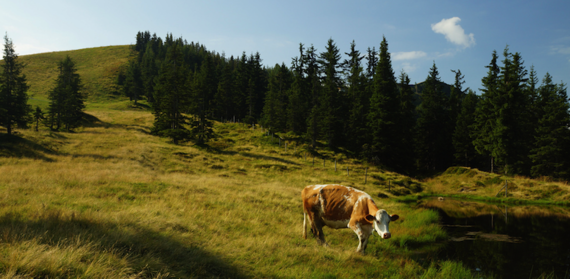Sustainability can be a problem at many dairies, but in this blog series intern Alicia gets the deets on some eco-friendly cheesemakers from across the map. Find out what makes each cheese green, and learn about the weekly contest for a chance to win an issue of culture.
When we first set out on this Green Cheese journey together, I told you about my catch-22: I love cheese, but I want to be kind to animals and the environment, too. The ugly truth is, those things aren't always compatible. So we've spent the last two months talking with cheesemakers across the country and globe, each focusing on a different aspect of sustainability. While many of us have a preconceived notion of what "sustainability" is, these cheesemakers not only all took a unique route towards reducing their impact on the environment and improving their animals' quality of life, but also incorporated aspects of sustainability I hadn't considered before: such as sustaining their communities. Some creameries took it one step farther, teaching other cheesemakers about their practices so that they may be implemented elsewhere.
At the start of our search for sustainable cheese, I wasn't sure what I would find. Investigating the negative effects that animal agriculture has on the environment had left me disheartened. Methane emissions, water pollution, rampant antibiotic use, and the ever-present buzzword global warming popped up over and over again in my research. Yet, when I moved on to interviewing cheesemakers, I was energized by not only their passion for green cheese, but also their drive to spread the word to others. And at the end of this series, I find myself encouraged by what these cheesemakers have accomplished. I've learned that with a little research into the cheese I buy, I can ensure that my dollar goes to a cause (and cheese) that I care about. I've learned that sustainability needn't be overly expensive or cost prohibitive. And best of all, I've learned that I've only scratched the surface of the green cheese movement. There are many more cheesemakers out there like those I spoke to, all working together to give cheese a better name.
It's been a fun ride, but all good things must end. Sadly, we've reached the conclusion to this Green Cheese series, but I hope you've learned as much as I have!
In our search for sustainable cheese we spoke with Straus Family Creamery, a California dairy who reduced emissions with their methane digester. Arizona's Black Mesa Ranch told us how they take advantage of their sunny climate and produce their goat's cheese with only solar and wind power. Cultured Cow Creamery in North Carolina showed us how they aid in the fight against world hunger with their focus on sourcing cow feed outside of the human food chain. Vermont's Grafton Village Cheese, the for-profit cheddar maker whose proceeds aid rural communities in the area, educated us on the importance of community involvement. Wisconsin-based cheesemaker Landmark Creamery showed us that you don't need to have fancy facilities or expensive technology to contribute to the eco-friendly cause. And lastly, Spanish Santa Gadea taught us about the amazing effective microorganism technology they use on their goat farm.
But what would a good blog series be without a grand prize giveaway? Learn more here.
